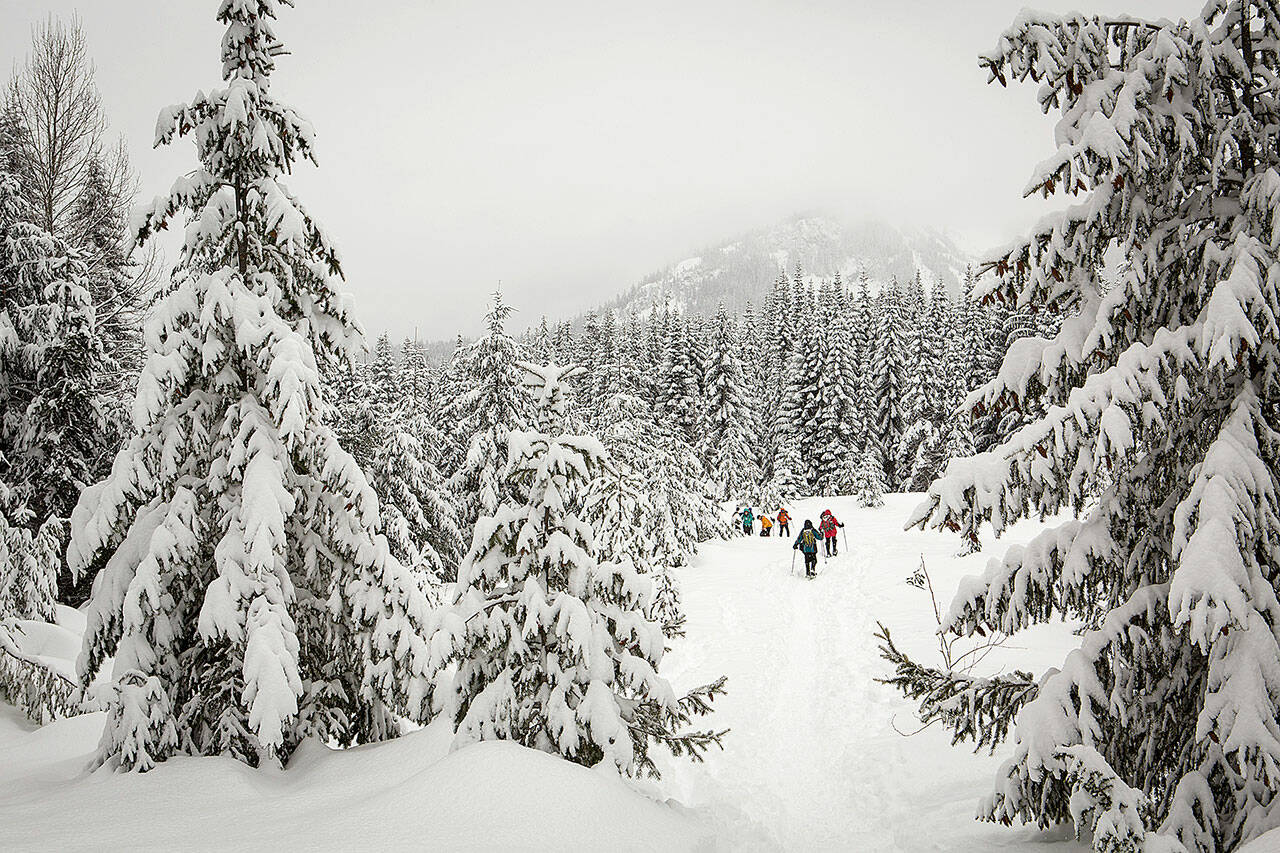Washington Trails Association
Winter exploration can present dangers that far exceed those of hiking in the summertime. Heavy snowfall followed by slow warming and rain can progressively load and stress a multitude of buried weak layers, creating dangerous avalanche conditions that not even the most experienced backcountry hikers should attempt.
Hikers and snowshoers need to do plenty of planning and take every precaution before hitting a trail during the winter months. Here are some tips for safer backcountry exploration in winter:
Always check avalanche conditions: Avalanches can strike even the most prepared winter hiker. Before going out on a snowy trail, definitely check the Northwest Avalanche Center online to determine local mountain weather and avalanche conditions.
Check the roads, check the weather: There is no shortage of good online resources for road conditions and mountain weather. For road conditions, WSDOT has up-to-date mountain pass conditions, including cameras on five well-traveled routes. It is also wise to call ahead to the ranger station where you plan to hike or snowshoe to determine current conditions, especially the local roads where storms or fallen trees can shut off routes unexpectedly. For mountain forecasts, try NOAA’s Washington Mountain Weather site. And the Northwest Avalanche Center’s website provides not only detailed avalanche forecasts but also comprehensive weather data and forecasts for the mountains. To gauge snow depth, check out this Washington snow map from the National Water and Climate Center.
Choose your destination wisely: Popular summer hiking trails such as McClellan Butte, Granite Mountain or Snow Lake become deadly avalanche hotspots in winter, and should never be considered as snowshoe destinations. Don’t assume an easy summer day hike will make a good snowshoe trip. Check our Hiking Guide and trip reports for up-to-date information or consult a guidebook to find the best low-risk snowshoe routes.
Let someone know where you are going: Always let someone know where you are going and when you expect to return (and call them when you do return!). You can find a trip plan form here to print, fill out and leave behind with someone you know before your next hike. If your destination changes, follow up and let someone know.
Pack the Ten Essentials, plus a few extra winter ones: The Ten Essentials include a topographic map and compass, hydration, extra food, extra clothing, a fire starter, a first-aid kit, a pocket knife, a flashlight, sun protection and an emergency shelter.
Some of these are extra important for winter hiking and snowshoeing:
■ Adequate extra clothing. Bring plenty of layers made of materials such as wool or polypropylene that wick sweat and moisture away from your body.
■ Headlamp or flashlight (and extra batteries). Because days are short and night comes quickly.
■ Plenty of extra food. Snowshoeing is strenuous exercise and you burn a lot of calories, so bring along plenty of extra food to keep your energy level high.
■ Plenty of water. Keep hydrated by drinking often.
■ Emergency shelter and/or sleeping bag. Seriously consider carrying these in case you have to hunker down for the night.
A few extra items to put in the winter pack include:
■ Portable shovel. A critically important winter survival tool, a shovel will assist you in digging snow caves in which you can survive a cold night. And it’s nearly impossible to dig someone out of an avalanche without one.
■ Avalanche beacon. The safest thing to do is to avoid avalanche country. However, if you choose to recreate in these risky areas, consider carrying an avalanche beacon and know how to use it properly.
Know how to find your way in the snow: Remember that it’s much easier to get yourself lost in winter — snow tends to obscure landmarks and makes the landscape look uniform. It’s not easy finding your way with nothing more than a paper map when you’re on an unfamiliar backcountry trail that is covered under a thick blanket of snow while clouds obscure the identifiable peaks around you. These conditions make map and compass skills essential for winter backcountry travel. Consider taking The Mountaineers’ wilderness navigation course or another winter skills course to gain confidence in route finding in a winter wonderland.
And remember that there are other snow risks beside avalanches — tree wells (the hollow at the base of a snow-covered tree) and snow cornices (brittle ledges of snow and ice) are on-trail dangers too. Knowing how to spot these features and avoid them, will ensure a safe outing.
Use common sense: Getting late in the afternoon? Is snow starting to fall in earnest? Is the trail hard to follow, or does it pass by a steep avalanche slope? As tempting as it may be to push on to your destination, knowing when to turn back can prevent a dire situation from developing. Attaining a summit or making it to a lake isn’t worth risking a night out in the cold or getting lost in a white-out.
It’s OK to turn back. You can always return on a different day.
It’s essential to consider these extra safety precautions, because heading out in the winter is riskier than your average summer day hike. This usually means a heavier pack, and a little more preparation time, but that just means you’ll burn more calories on your trip, and you’ll return safely to your car, where you can warm up with a hot chocolate and extra whipped cream on your way home.
For more information on how to hike safely and responsibly in the winter, and all year long, go to wta.org/trailsmarts.
Washington Trails Association promotes hiking as a way to inspire a people to protect Washington’s natural places. Learn more at www.wta.org.
Talk to us
> Give us your news tips.
> Send us a letter to the editor.
> More Herald contact information.

























